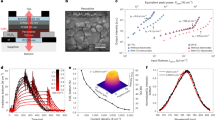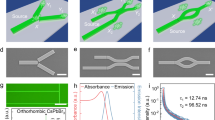Abstract
Low-temperature solution-processed materials that show optical gain and can be embedded into a wide range of cavity resonators are attractive for the realization of on-chip coherent light sources. Organic semiconductors and colloidal quantum dots are considered the main candidates for this application. However, stumbling blocks in organic lasing1,2,3,4 include intrinsic losses from bimolecular annihilation and the conflicting requirements of high charge carrier mobility and large stimulated emission; whereas challenges pertaining to Auger losses and charge transport in quantum dots5,6,7 still remain. Herein, we reveal that solution-processed organic–inorganic halide perovskites (CH3NH3PbX3 where X = Cl, Br, I), which demonstrated huge potential in photovoltaics8,9,10,11, also have promising optical gain. Their ultra-stable amplified spontaneous emission at strikingly low thresholds stems from their large absorption coefficients, ultralow bulk defect densities and slow Auger recombination. Straightforward visible spectral tunability (390–790 nm) is demonstrated. Importantly, in view of their balanced ambipolar charge transport characteristics8, these materials may show electrically driven lasing.
This is a preview of subscription content, access via your institution
Access options
Subscribe to this journal
Receive 12 print issues and online access
$259.00 per year
only $21.58 per issue
Buy this article
- Purchase on Springer Link
- Instant access to full article PDF
Prices may be subject to local taxes which are calculated during checkout



Similar content being viewed by others
References
Kozlov, V. G., Bulovic, V., Burrows, P. E. & Forrest, S. R. Laser action in organic semiconductor waveguide and double-heterostructure devices. Nature 389, 362–364 (1997).
Namdas, E. B. et al. Low thresholds in polymer lasers on conductive substrates by distributed feedback nanoimprinting: progress toward electrically pumped plastic lasers. Adv. Mater. 21, 799–802 (2009).
Clark, J. & Lanzani, G. Organic photonics for communications. Nature Photon. 4, 438–446 (2010).
Grivas, C. & Pollnau, M. Organic solid-state integrated amplifiers and lasers. Laser Photon. Rev. 6, 419–462 (2012).
Dang, C. et al. Red, green and blue lasing enabled by single-exciton gain in colloidal quantum dot films. Nature Nanotech. 7, 335–339 (2012).
Klimov, V. I. Spectral and dynamical properties of multiexcitons in semiconductor nanocrystals. Annu. Rev. Phys. Chem. 58, 635–673 (2007).
Chan, Y. et al. Blue semiconductor nanocrystal laser. Appl. Phys. Lett. 86, 073102 (2005).
Xing, G. et al. Long-range balanced electron- and hole-transport lengths in organic–inorganic CH3NH3PbI3 . Science 342, 344–347 (2013).
Burschka, J. et al. Sequential deposition as a route to high-performance perovskite-sensitized solar cells. Nature 499, 316–319 (2013).
Kim, H. S. et al. Lead iodide perovskite sensitized all-solid-state submicron thin film mesoscopic solar cell with efficiency exceeding 9%. Sci. Rep. 2, 591 (2012).
Heo, J. H. et al. Efficient inorganic-organic hybrid heterojunction solar cells containing perovskite compound and polymeric hole conductors. Nature Photon. 7, 486–491 (2013).
Ding, J., Hagerott, M., Ishihara, T., Jeon, H. & Nurmikko, A. V. (Zn, Cd)Se/ZnSe quantum-well lasers: Excitonic gain in an inhomogeneously broadened quasi-two-dimensional system. Phys. Rev. B 47, 10528–10542 (1993).
Xing, G. et al. Ultrafast exciton dynamics and two-photon pumped lasing from ZnSe nanowires. Adv. Opt. Mater. 1, 319–326 (2013).
Liu, X., Zhang, Q., Xiong, Q. & Sum, T. C. Tailoring the lasing modes in semiconductor nanowire cavities using intrinsic self-absorption. Nano Lett. 13, 1080–1085 (2013).
Xia, R., Heliotis, G. & Bradley, D. D. Fluorene-based polymer gain media for solid-state laser emission across the full visible spectrum. Appl. Phys. Lett. 82, 3599–3601 (2003).
Sun, S. et al. The origin of high efficiency in low-temperature solution-processable bilayer organometal halide hybrid solar cells. Energy Environ. Sci. 7, 399–407 (2014).
Wehrenfennig, C., Eperon, G. E., Johnston, M. B., Snaith, H. J. & Herz, L. M. High charge carrier mobilities and lifetimes in organolead trihalide perovskites. Adv. Mater. (2013)10.1002/adma.201305172
Shaklee, K. L. & Leheny, R. F. Direct determination of optical gain in semiconductor crystals. Appl. Phys. Lett. 18, 475–477 (1971).
Liao, Y., Xing, G., Mishra, N., Sum, T. C. & Chan, Y. Low threshold, amplified spontaneous emission from core-seeded semiconductor nanotetrapods incorporated into a sol–gel matrix. Adv. Mater. 24, 159–164 (2012).
Lampert, Z. E., Reynolds Jr., C. L., Papanikolas, J. M. & Aboelfotoh, M. O. Controlling morphology and chain aggregation in semiconducting conjugated polymers: the role of solvent on optical gain in MEH-PPV. J. Phys. Chem. B. 116, 12835–12841 (2012).
Xing, G. et al. Charge transfer dynamics in Cu-doped ZnO nanowires. Appl. Phys. Lett. 98, 102105 (2011).
Uhd Jepsen, P. et al. Ultrafast carrier trapping in microcrystalline silicon observed in optical pump-terahertz probe measurements. Appl. Phys. Lett. 79, 1291–1293 (2001).
Mehraeen, S., Coropceanu, V. & Bredas, J. L. Role of band states and trap states in the electrical properties of organic semiconductors: Hopping versus mobility edge model. Phys. Rev. B 87, 195209 (2013).
Willa, K. et al. From organic single crystals to solution processed thin-films: charge transport and trapping with varying degree of order. J. App. Phys. 113, 133707 (2013).
Graetzel, M., Janssen, R. A. J., Mitzi, D. B. & Sargent, E. H. Materials interface engineering for solution-processed photovoltaics. Nature 488, 304–312 (2012).
Baikie, T. et al. Synthesis and crystal chemistry of the hybrid perovskite (CH3NH3)PbI3 for solid-state sensitised solar cell applications. J. Mater. Chem. A 1, 5628–5641 (2013).
Laubsch, A., Sabathil, M., Baur, J., Peter, M. & Hahn, B. High-power and high-efficiency InGaN-based light emitters. IEEE T. Electr. Dev. 57, 79–87 (2010).
Zhang, S. et al. Preparations and characterizations of luminescent two dimensional organic–inorganic perovskite semiconductors. Materials 3, 3385–3406 (2010).
Mulmudi, H. K. et al. Flexible, low-temperature, solution processed ZnO-based perovskite solid state solar cells. Chem. Commun. 49, 11089–11091 (2013).
Acknowledgements
We would like to acknowledge D. Giovanni for the data fitting and C. W. Kiang for the electroluminescence measurement, as well as S. Shuangyong, J. Chua, T. Krishnamoorthy and S. Kulkarni for sample and precursor preparation. Financial support from NTU start-up grants M4080514 and M4081293, SPMS collaborative Research Award M4080536, Ministry of Education AcRF Tier 2 grant MOE2013-T2-1-081 and from the Singapore NRF through the Competitive Research Program (NRF-CRP4-2008-03) and the Singapore-Berkeley Research Initiative for Sustainable Energy (SinBeRISE) CREATE Programme is gratefully acknowledged. M.G. thanks the European Research Council for financial support under the Advanced Research Grant (ARG 247404) ‘Mesolight’.
Author information
Authors and Affiliations
Contributions
G.X., N.M. and T.C.S. conceived the idea for the manuscript and designed the experiments. G.X. developed the basic concepts, conducted the spectroscopic characterization and coordinated the experiments. N.M. and D.S. fabricated and characterized the samples. N.Y., X.L., M.G. and S.M. contributed to the data analysis. T.C.S., N.M., G.X., S.M. and S.S.L. analysed the data and wrote the paper. T.C.S. and N.M. led the project.
Corresponding authors
Ethics declarations
Competing interests
The authors declare no competing financial interests.
Supplementary information
Supplementary Information
Supplementary Information (PDF 1880 kb)
Rights and permissions
About this article
Cite this article
Xing, G., Mathews, N., Lim, S. et al. Low-temperature solution-processed wavelength-tunable perovskites for lasing. Nature Mater 13, 476–480 (2014). https://doi.org/10.1038/nmat3911
Received:
Accepted:
Published:
Issue Date:
DOI: https://doi.org/10.1038/nmat3911
This article is cited by
-
Ultrafast optical investigation of carrier and spin dynamics in low-dimensional perovskites
Science China Technological Sciences (2024)
-
Crystal growth, Hirshfeld analysis, thermal behavior and magnetic properties of a new hybrid material (C5H14N2)[MnCl3(H2O)3]Cl
Journal of the Iranian Chemical Society (2024)
-
Metal Halide Perovskite for next-generation optoelectronics: progresses and prospects
eLight (2023)
-
Compact spin-valley-locked perovskite emission
Nature Materials (2023)
-
The rise of halide perovskite semiconductors
Light: Science & Applications (2023)



